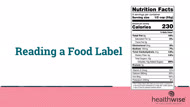Nutrition
Reading Food Labels
A food label can be a handy guide when you're making choices about what foods to eat.
You just have to know what to look for. Here are some things to check first.
Start with the serving size.
The calories and nutrients listed on the rest of a Nutrition Facts food label are based on one serving.
So, if the label says that the serving size is a half cup and you eat one cup, you're getting twice the amount of calories and other nutrients listed on the label.
You can find the amount of calories listed in bold below the serving size.
You can use that to see how the food fits into your total daily calorie needs.
The Nutrition Facts food label uses 2,000 calories a day as a general recommendation.
But keep in mind that each person is different and your daily calorie needs may be more or less than this.
The percent Daily Value, or DV, shows how much of a nutrient is in a serving, based on how much of the nutrient you need every day.
You can use the percent Daily Value to figure out if a serving of food is high or low in nutrients like saturated fat, sodium, fiber, and added sugars.
If the Daily Value is 5% or less for a nutrient, it means that the food is low in that nutrient.
If the Daily Value is 20% or more for a nutrient, it means that the food is high in that nutrient.
Okay. Let's go over some other things you might see on the label.
We'll start with nutrients that you may want to limit.
Check the label for saturated and trans fats. Try to limit these types of fats.
Choose foods with less sodium. Check the label.
Foods that have 5% or less of the Daily Value per serving are low in sodium.
Foods that have 20% or more of the Daily Value per serving are high in sodium.
Check for added sugars. These are sugars that are added to foods during processing.
You can limit the amount of added sugars you eat by choosing foods that have less than 5% of the Daily Value per serving for added sugars.
Now let's look at nutrients you may want more of in your diet.
You can use the food label to find out how much fiber, vitamin D, calcium, iron, and potassium are in a food.
These are nutrients that many people need more of in their diets.
One more thing. By checking the ingredients list, you can see everything that's in a food.
The ingredients are listed in order by amount.
So if an ingredient is higher on the list, it means there's more of it in that food.
So now that you know what to look for, remember to check food labels when you shop.
It can make a big difference when you're trying to eat healthier.
Credits
- Current as of
- 10 07, 2024
- Author
- Medical Review
-
